By Marcie O’Connor
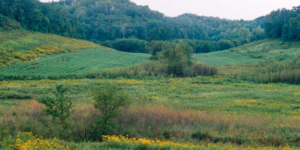
View from the road – summer of 2000 – the summer we bought the farm.
Our adventure began in early 2000 when my husband and I bought 500 acres of an old farm in the Driftless Area of western Wisconsin. The Driftless Area is the part of the Midwest that was never covered by glaciers, so the land is beautiful – with steep hills and narrow valleys. Because of its rugged terrain, it still has many remnants of the pre-settlement landscape: dry bluff prairies, overgrown savannas, sedge meadows, wet prairies, and oak woodland. I was interested in native plants and natural landscapes, so I thought it would be fun to see if we could return the land to the way it was before it was farmed.
It’s been a wonderful project – fun and interesting and challenging. We had no idea how hard it would be, how much we’d have to learn, or how long it would take. We’re guessing it will take at least 150 years, so we still have a long way to go.
Our land had been a dairy farm since the mid-1800s. There were 150 acres of crop fields, a degraded wetland surrounding a spring-fed creek, and heavily grazed woods and fields. When we bought the land, the fields were rented out to a local farmer and being planted in alternating crops of corn and soybeans. Our first project was to plant prairie in all those old crop fields. Each year we took about 20 acres out of production and planted it into prairie. It took us eight years to do them all. I collected about half the seeds we used and bought the rest from native plant nurseries. I ‘frost seeded’ most of the fields during the winter – throwing the seeds out on top of the snow. Now the youngest of those prairies is 14 years old.
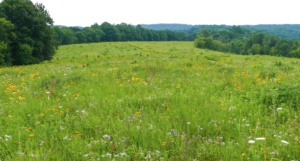
Planted Prairie in an old crop field – 15 years old.
We have five large bluff prairie remnants – steep south-facing hilltops that still had some open prairie but were being invaded by brush and trees around the edges. The narrow tops are flat, but the sides are steep and difficult to access. We’ve been working to enlarge these remnants – cutting and removing the invading brush. Since they’re so steep, most of the work needs to be done by hand – cutting with chainsaws and hand clippers, treating the stumps with herbicide, so they don’t grow back. Once the ground layer gets more sun, prairie plants that have been struggling under the brush start to grow and flower again.
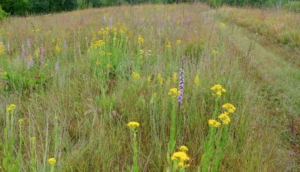
Restored prairie remnant is alive with insects and native flowers.
Much of the woods are overgrown savanna, choked with invasive species, brush and small trees. Every fall, we make a project out of clearing out as large an area as possible before the snow falls. We do the same kind of clearing here – cutting and treating brush and trees, but in the flatter areas, we can mow, which makes the projects go faster. Over the years, our restored savanna area has been growing – becoming more open, with savanna plants growing back under the trees.
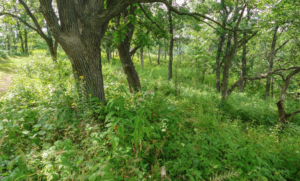
Restored savanna
The wetland remnants have been some of the most challenging to restore because of two aggressive invasive species: Wild Parsnip and Reed Canary Grass. But after years of battling them and replanting wet fields along the creek with wetland species, we’re seeing encouraging progress.
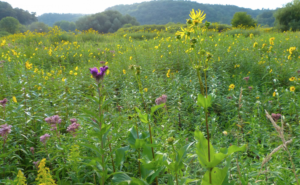
Restored Wetland has lots of milkweed to feed the monarch butterflies.
My background is in botany, so at the beginning of the project, I concentrated on the plants. But as the native plant communities have matured and the habitats have improved, we’re seeing all kinds of native animals. I’ve been trying to observe and learn as much as I can about them and about the intricate web of interactions they have with one another.
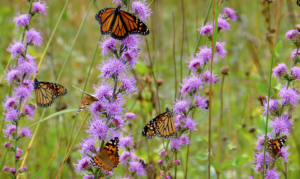
Monarchs and Painted Ladies (butterflies) on Rough Blazing-star.
Some of the most important animals in this food web are the insects. They’re beautiful and exciting in themselves, but they’re also an important food source for larger creatures. I love seeing nibbled, folded, and curled leaves – it’s a sign that insects are finding my habitats and rebuilding that web of connections with other creatures.
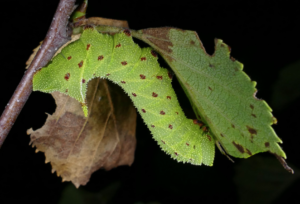
Blinded Sphinx Moth caterpillar eating birch leaves.
The insects I’ve learned the most about are butterflies and moths. I watch for butterflies during the day and set up lights on warm nights to attract moths (and other nighttime creatures). I make sure to turn off the lights when I’m finished, and the farm is in complete darkness the rest of the time. We have no outside lights. So far, I’ve seen 83 species of butterflies here and more than 900 species of moths. The caterpillars of moths and butterflies are often particular about which plants they’ll eat – so finding that many species tells me that we’re creating diverse and healthy habitats.
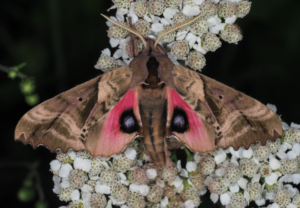
Blinded Sphinx Moth adult.
We love living in the midst of all these interesting creatures and being able to watch what they do. We’re looking forward to another 130 years of rebuilding habitats and learning about the creatures that live in them.
To learn more about our project and see more pictures of the land and the plants and animals we’ve seen here, visit our website: Prairie Haven
About the Author
Marcie O’Connor grew up in the city of Chicago but began learning about native plants when she was 10 years old. She studied botany and ecology in college and has remained interested in plants and restoration ecology ever since. Since 2000 she and her husband Mike have been working to restore their land in the Driftless Area of western Wisconsin back to the prairie and savanna landscape that was there before the European settlers arrived.
***
Each author appearing herein retains original copyright. Right to reproduce or disseminate all material herein, including to Columbia University Library’s CAUSEWAY Project, is otherwise reserved by ELA. Please contact ELA for permission to reprint.
Mention of products is not intended to constitute endorsement. Opinions expressed in this newsletter article do not necessarily represent those of ELA’s directors, staff, or members.

